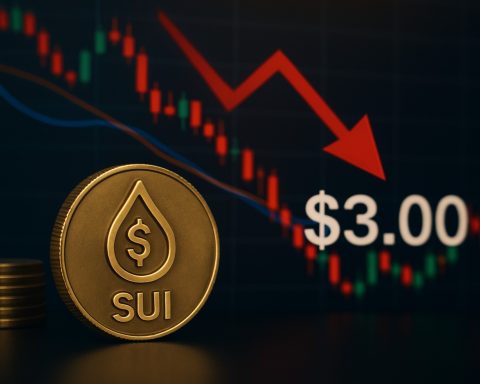- IOTA utilizes Tangle, a Directed Acyclic Graph (DAG) technology, diverging from traditional blockchain systems.
- Designed for the Internet of Things (IoT), IOTA enables fee-less transactions through user-validated processes, enhancing scalability and efficiency.
- The unique system eliminates energy-intensive mining, making it environmentally friendly.
- IOTA emphasizes a zero-fee environment, allowing seamless micropayments and larger transactions without financial barriers.
- Security challenges have been addressed following a significant hack in 2017, with ongoing improvements for quantum-proofing.
- Despite market fluctuations, IOTA remains at the forefront with its innovative approach, aiming to revolutionize digital transactions within IoT networks.
- IOTA’s development reflects a commitment to technological advancement and connectivity in an increasingly digital world.
Imagine a bustling digital realm where devices communicate seamlessly, conducting transactions without incurring hefty fees or energy consumption. Enter IOTA, a trailblazing cryptocurrency that dismisses traditional blockchain for a novel architecture known as Tangle. Born from the innovative minds of German developers, IOTA thrives on the Directed Acyclic Graph (DAG) technology, designed specifically for the burgeoning Internet of Things (IoT).
In this intricate system, every IOTA user plays a dual role. To validate a transaction, users must first verify two others, thus eliminating the need for energy-guzzling miners. This unique method not only speeds up the process but also makes it remarkably scalable. Imagine processing countless transactions without breaking a sweat or draining your resources.
A hallmark of IOTA’s architecture is its commitment to a zero-fee environment. Every operation, from microscopic payments to larger transactions, unfolds without charging extra, promising a future where digital currency flows freely across devices, unhindered by financial barricades.
However, with innovation comes challenges. IOTA’s venture into quantum-proof security had its setbacks. In 2017, an infamous hack shook its foundations, casting doubts yet driving improvements. Security remains a moving target in this digital landscape.
Amidits fluctuating market presence, IOTA continues to attract attention with its futuristic vision and unique blend of technology. It seeks to redefine how we perceive digital transactions, offering a tantalizing glimpse into a future where the Internet of Things not only connects but also transacts without constraint.
As the world becomes more connected, IOTA stands as a beacon of innovation, potential, and adaptability. Its journey is a testament to the relentless pursuit of pushing technological boundaries.
Unlocking the Potential of IOTA: The Future of Transactions in the IoT Era
Overview of IOTA’s Tangle Technology
IOTA distinguishes itself from traditional blockchain-based cryptocurrencies with its use of Tangle, which operates on a Directed Acyclic Graph (DAG) instead of a linear chain of blocks. Unlike Bitcoin or Ethereum that require miners to validate transactions, IOTA users themselves validate each other’s transactions. This decentralized approach significantly reduces energy consumption and eliminates transaction fees, opening doors for its application in scalable, machine-to-machine (M2M) microtransactions within the Internet of Things (IoT) ecosystem.
Real-World Use Cases and Industry Trends
1. IoT Integration: IOTA’s architecture is perfectly suited for IoT, where devices frequently interact and conduct transactions. It allows tiny, cost-free transactions, making it feasible for smart devices to purchase and sell data autonomously.
2. Smart Cities: Leveraging IOTA technology could streamline urban operations, such as traffic management, infrastructure maintenance, and even public transportation systems, by facilitating seamless microtransactions between machines.
3. Supply Chain Management: IOTA could play a pivotal role in supply chains by providing a tamper-proof, real-time ledger of transactions and movements, ensuring transparency and reducing inefficiencies.
Limitations and Security Concerns
While IOTA offers numerous advantages, it has faced challenges, particularly regarding security. The 2017 hack highlighted vulnerabilities in IOTA’s initial cryptographic algorithms. Although improvements have since been made, security remains a critical area requiring constant vigilance. Users must remain aware of these concerns, ensure they use updated software versions, and implement best practices in cybersecurity.
Market Forecasts and Industry Trends
The cryptocurrency market is volatile, but IOTA’s focus on IoT transactions positions it uniquely. As IoT technologies expand, IOTA’s relevance and adoption could increase considerably. According to a report by Verified Market Research, the global IoT market is projected to reach USD 1.46 trillion by 2027, suggesting a vast potential landscape for IOTA’s application.
Competitor Comparison
Compared to other cryptocurrencies, IOTA’s zero-fee transactions and energy efficiency set it apart. However, blockchain-based cryptocurrencies like Ethereum offer smart contracts, which IOTA is working to incorporate but is not yet fully realized.
Predictions and Future Insights
As quantum computing develops, quantum-proofing remains a priority. IOTA’s ongoing research aims to reinforce its cryptographic foundation against future threats. Additionally, adaptability to regulatory environments will be pivotal in ensuring successful integration into global economic systems.
Actionable Recommendations
1. Stay Informed: Regularly follow IOTA’s official website for updates on platform developments and security enhancements.
2. Secure Your Wallet: Use reputable software wallets, and enable two-factor authentication to enhance security.
3. Explore Integration Opportunities: Businesses, particularly those in tech-driven sectors, should explore potential IOTA implementations to leverage cost-effective, scalable microtransactions.
4. Monitor Industry Trends: Keep abreast of IoT and cryptocurrency trends to identify aligning opportunities for investment or business innovation.
In summary, IOTA presents a promising alternative to traditional cryptocurrencies, particularly for IoT applications. However, like any emerging technology, it requires cautious engagement, with attention to security and market developments to capitalize on its full potential.









